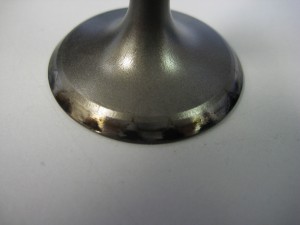Problem:
A new Subaru customer asked for assistance in finding out why a pair of recently reconditioned cylinder heads had ran very poorly at start-up. The workshop controller was concerned that valves may have been bent during their fitting of the heads because he admitted that one head had had its camshafts set 180 degrees out. When this cam timing was corrected, the compression test was very low on that side of the engine. Bent valves were suspected. However, when the head was removed, there appeared to be no damage or witness marks in the pistons to indicate valves had hit them. Valves certainly appeared to be seating normally.
Cause:
When the valves were removed from the head, clear evidence of poor machining was found. The accompanying photos show the machining chatter around the valve seats and on the valve faces.
What is chatter?
Machining chatter occurs when the cutting edge of the tool flexes under the shear force required to “cut” or “shear” the material. Under correct conditions, this shear force is a single loading of the cutting edge until the shear force is reached followed by a continuous and controlled cutting or shearing of the material. However, when the cutting tool is NOT rigid or NOT held securely, the cutting edge will bend until the shear force is reached followed by a repeat again and again as the material is machined. This does not achieve a continuous and even loading of the cutting edge and is associated with noise from this intermittent shearing process.
The effect of this is also evident in the surface finish generated by the cutting edge flexing away from the material as the shear force builds up followed by a plunge back into the material as the shear force is reached and cutting begins again. This is the machining “chatter” shown in the photos as evenly spaced shiny spots, where the valve and seat are contacting, and the dark spots, where the valve and seat are not contacting. The two surfaces are actually hills and valleys of the chatter.
The chatter on the valve seat is most commonly due to poor tooling being used. For examples: loose cutting tool, perhaps a loose or worn pilot; an incorrectly sharpened or worn cutting edge; or loosely clamped work piece are the common errors.
The chatter on the valve face is most probably caused by a poorly dressed grinding wheel This also operates on the shear process explained above but as a multiple of cutting edges in the grinding wheel rather than as a single cutting edge as with the tool used to cut a seat. The process is still one of shearing the metal being “cut”.
Cure:
The cure for these cylinder heads was to re-machine the valves and seats correctly and the engine then ran fine.
As for the original repairer’s issues, they would best be corrected with staff training and inspection of the end product before the work leads to problems and a lost customer.




